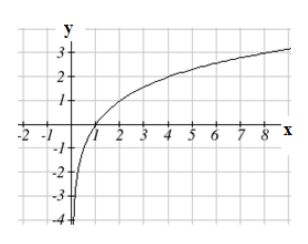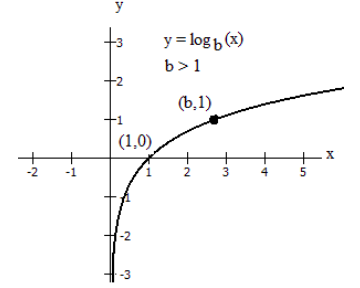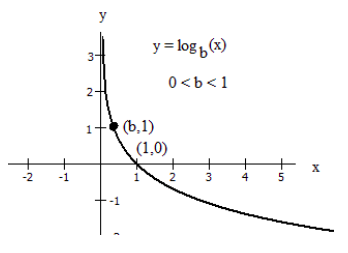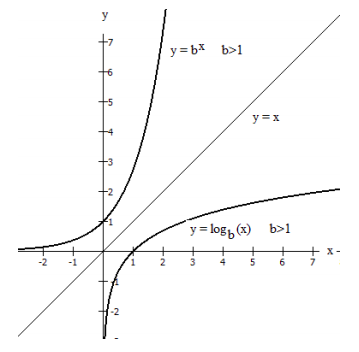7.4: Graphs and Properties of Logarithmic Functions
- Page ID
- 40182
Learning Objectives
In this section, you will learn to:
- Examine properties of logarithmic functions.
- Examine graphs of logarithmic functions.
- Examine the relationship between graphs of exponential and logarithmic functions.
Prerequisite Skills
Before you get started, take this prerequisite quiz.
1. Consider \(f(x)=2^x\).
a. Graph \(f(x)\).
b. Identify any \(x-\) or \(y-\) intercepts.
c. Identify any asymptotes.
d. Identify the point (1, ___).
- Click here to check your answer
-
a.

b. \(f(x)=2^x\) has a \(y-\)intercept at (0, 1).
c. \(f(x)=2^x\) has an asymptote at \(y=0\).
d. \(f(x)=2^x\) includes the point (1, 2).
If you missed this problem, review Section 7.2. (Note that this will open in a new window.)
2. Consider \(g(x)=5^x\).
a. Graph \(g(x)\).
b. Identify any \(x-\) or \(y-\) intercepts.
c. Identify any asymptotes.
d. Identify the point (1, ___).
- Click here to check your answer
-
a.

b. \(g(x)=5^x\) has a \(y-\)intercept at (0, 1).
c. \(g(x)=5^x\) has an asymptote at \(y=0\).
d. \(g(x)=5^x\) includes the point (1, 5).
If you missed this problem, review Section 7.2. (Note that this will open in a new window.)
3. Consider \(h(x)=e^x\).
a. Graph \(h(x)\).
b. Identify any \(x-\) or \(y-\) intercepts.
c. Identify any asymptotes.
d. Identify the point (1, ___).
- Click here to check your answer
-
a.

b. \(h(x)=e^x\) has a \(y-\)intercept at (0, 1).
c. \(h(x)=e^x\) has an asymptote at \(y=0\).
d. \(h(x)=e^x\) includes the point (1, e), roughly (1, 2.718).
If you missed this problem, review Section 7.2. (Note that this will open in a new window.)
Recall that the exponential function \(f(x) = 2^x\) produces this table of values
|
\(x\) |
-3 |
-2 |
-1 |
0 |
1 |
2 |
3 |
|
\(f(x)\) |
1/8 |
1/4 |
1/2 |
1 |
2 |
4 |
8 |
Since the logarithmic function is an inverse of the exponential, \(g(x)=\log_{2}(x)\) produces the table of values
|
\(x\) |
1/8 |
1/4 |
1/2 |
1 |
2 |
4 |
8 |
|
\(g(x)\) |
-3 |
-2 |
-1 |
0 |
1 |
2 |
3 |
In this second table, notice that
- As the input increases, the output increases.
- As input increases, the output increases more slowly.
- Since the exponential function only outputs positive values, the logarithm can only accept positive values as inputs, so the domain of the log function is \((0, \infty)\).
- Since the exponential function can accept all real numbers as inputs, the logarithm can have any real number as output, so the range is all real numbers or \((-\infty, \infty)\).

Plotting the graph of \(g(x) = \log_{2}(x)\) from the points in the table, notice that as the input values for \(x\) approach zero, the output of the function grows very large in the negative direction, indicating a vertical asymptote at \(x = 0\).
In symbolic notation we write
as \(x \rightarrow 0^{+}\), \(f(x) \rightarrow-\infty\)
and as \(x \rightarrow \infty, f(x) \rightarrow \infty\)
Graphically, in the function \(g(x) = \log_{b}(x)\), \(b > 1\), we observe the following properties:

- The graph has a horizontal intercept at (1, 0)
- The line x = 0 (the y-axis) is a vertical asymptote; as \(x \rightarrow 0^{+}, y \rightarrow-\infty\)
- The graph is increasing if \(b > 1\)
- The domain of the function is \(x > 0\), or (0, \(\infty\))
- The range of the function is all real numbers, or \((-\infty, \infty)\)
However if the base \(b\) is less than 1, 0 < \(b\) < 1, then the graph appears as below.
This follows from the log property of reciprocal bases : \(\log _{1 / b} C=-\log _{b}(C)\)

- The graph has a horizontal intercept at (1, 0)
- The line x = 0 (the y-axis) is a vertical asymptote; as \(x \rightarrow 0^{+}, y \rightarrow \infty\)
- The graph is decreasing if 0 < \(b\) < 1
- The domain of the function is \(x\) > 0, or (0, \(\infty\))
- The range of the function is all real numbers, or \((-\infty, \infty)\)
When graphing a logarithmic function in the form \(f(x) = \log_{b}(x)\), it can be helpful to remember that the graph will pass through the points (1, 0) and (\(b\), 1).
Example \(\PageIndex{1}\)
Sketch each of the following functions by graphing the vertical asymptote, the intercept, and the point (\(b\), 1).
- \(f(x) = \log_{2}(x)\)
- \(g(x) = \log_{5}(x)\)
- \(h(x) = \log(x)\)
- \(j(x) = \ln(x)\)
Solution
All logarithmic graphs in the form \(f(x) = \log_{b}(x)\) will have a vertical asymptote on the y-axis and an x-intercept at (1, 0).
a. \(f(x) = \log_{2}(x)\) will have a point at (2, 1).
b. \(g(x) = \log_{5}(x)\) will have a point at (5, 1).
c. \(h(x) = \log(x)\) represents the common log and has a base of 10, therefore it will have a point at (10, 1).
d. \(j(x) = \ln(x)\) represents the natural log and has a base of e, therefore it will have a point at (e, 1).
Finally, we compare the graphs of \(y = b^x\) and \(y = \log_{b}(x)\), shown below on the same axes.
Because the functions are inverse functions of each other, for every specific ordered pair
(\(h\), \(k\)) on the graph of \(y = b^x\), we find the point (\(k\), \(h\)) with the coordinates reversed on the graph of \(y = \log_{b}(x)\).
In other words, if the point with \(x = h\) and \(y = k\) is on the graph of \(y = b^x\), then the point with \(x = k\) and \(y = h\) lies on the graph of \(y = \log_{b} (x)\)
The domain of \(y = b^x\) is the range of \(y = \log_{b} (x)\)
The range of \(y = b^x\) is the domain of \(y = \log_{b} (x)\)
For this reason, the graphs appear as reflections, or mirror images, of each other across the diagonal line \(y=x\). This is a property of graphs of inverse functions that students should recall from their study of inverse functions in their prerequisite algebra class.

|
\(\bf{y = b^x}\), with \(\bf{b>0}\) |
\(\bf{y = \log_{b} (x)}\), with \(\bf{b>0}\) |
|
|---|---|---|
|
Domain |
all real numbers |
all positive real numbers |
|
Range |
all positive real numbers |
all real numbers |
|
Intercepts |
(0,1) |
(1,0) |
|
Asymptotes |
Horizontal asymptote is As \(x \rightarrow-\infty, \: y \rightarrow 0\) |
Vertical asymptote is As \(x \rightarrow 0^{+}, \: y \rightarrow-\infty\) |
Source: The material in this section of the textbook originates from David Lippman and Melonie Rasmussen, Open Text Bookstore, Precalculus: An Investigation of Functions, “Chapter 4: Exponential and Logarithmic Functions,” licensed under a Creative Commons CC BY-SA 3.0 license. The material here is based on material contained in that textbook but has been modified by Roberta Bloom, as permitted under this license.


